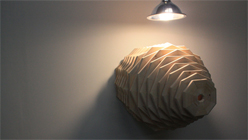Recology San Francisco is the only garbage dump in the country that hosts a rotating artist-in-residence program. Artists are granted studio space for four months, along with a stipend and free access to items dropped off in the Public Disposal and Recycling (PDR) area. It is essentially the penultimate dumpster diving experience: anything and everything, from old electronics to musical instruments and every other possible art material under the sun, appears at some point, free for the unlimited taking. Resident artists must use only that which they salvage from the PDR to make new work while in residence. Founded in 1990 by artist Jo Hanson, by the end of this year the Recology San Francisco A. I. R. program will have served 99 artists, including the likes of Val Britton, Packard Jennings, Christine Lee, and Scott Oliver. Current resident artists Terry Berlier and Donna Anderson Kam present the fruits of their labor in a two-day reception in the on-site studio this weekend.

Terry Berlier
The Beginning and the End Meet
Photo: Micah Gibson
The residency program is an exercise in resourcefulness and a resounding statement about the surplus generated by consumer culture. Upon arrival, Berlier wondered about the possibility of procuring a piano. Within two days a perfectly suitable upright was brought to the dump and snagged for deconstruction in her studio. A fully functioning MacBook computer dropped off for electronics recycling is among other plethora implemented in the construction of the artist’s sculptural new media installations. An assistant professor of sculpture at Stanford University, Berlier took a sabbatical to work in her dump studio. She notes that “the residency has blown up my practice” through the wealth of raw materials available daily as people arrive hourly with carloads of stuff cleared out of their homes, offices and storage spaces. For someone like Berlier, who previously worked with found objects, the residency can be an overwhelming abundance of raw materials for art-making. The anticipated challenge of finding supplies for artists who have more narrowly focused practices can be nerve wracking. But the experience can also lead to new discoveries, such as for Anderson Kam, whose practice prior to the residency focused on drawing on conventional paper. During the residency, she has begun experimenting with new materials, such as the cast-off perforated vinyl advertising skins from transit buses. Oversized cardboard spools have spurred her development of continuous narratives drawn on their circular surfaces.





